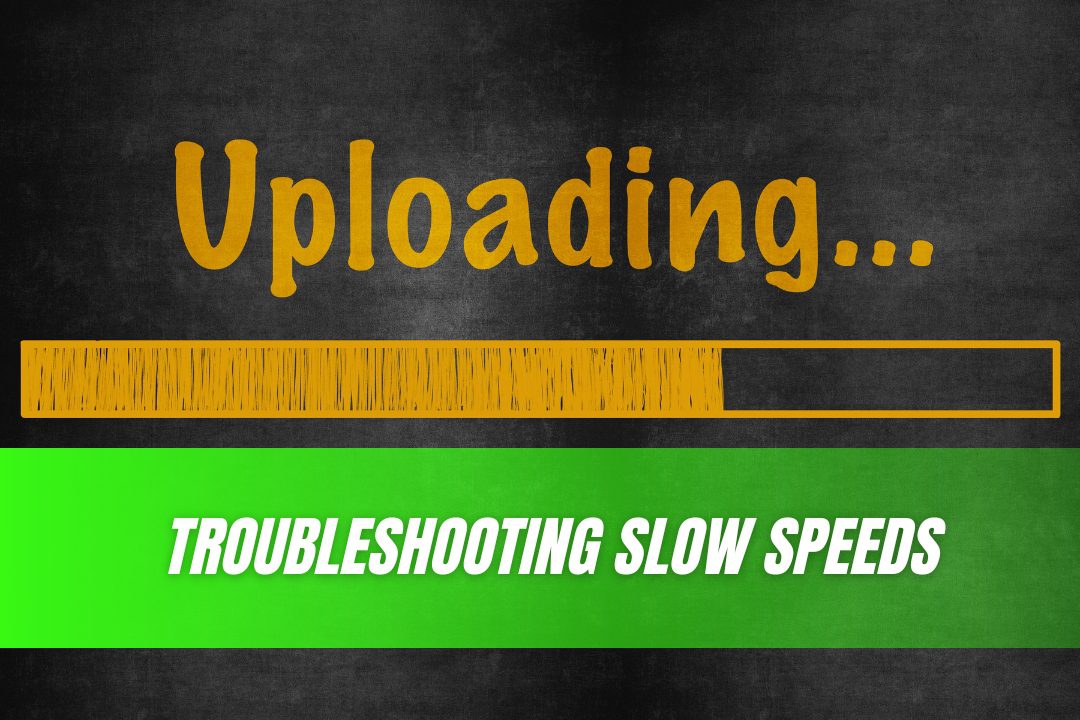How Does an Internet Speed Test Work?
From speed testing platforms to final results, this article looks at how speed tests work.
How Does a Speed Test Work?
When you run a speed test, the tool sends a request to a server to download a file. The time it takes for the file to be downloaded is measured, and this time is used to calculate the download speed of the connection. The same process is followed to measure the upload speed, but in this case, the speed test tool sends a file to the server rather than requesting a download.
Speed tests work in a series of steps:
1. You Click The Speed Test Button: It all starts on an internet speed testing website, such as Speedtest.net, Fast.com, or Ookla. This is point you hover your cursor over the test my speed button. When you click that button the test begins.
2. A Connection Is Made To A Remote Server: The first thing that happens after you click that button is that your device establishes a connection to a remote server maintained by the testing website. The server is usually located at a different geographical location from the your device to simulate real-world usage of the internet. Now here’s the technical bit. To establish a connection to the remote server, your device uses a protocol called Transmission Control Protocol (TCP). TCP is a reliable and connection-oriented protocol that ensures that data is transmitted accurately and efficiently between two devices over the internet. When the your device initiates a connection to the remote server, it sends a “SYN” (synchronize) packet to the server. The remote server responds with a “SYN-ACK” (synchronize-acknowledge) packet to confirm the connection. The user’s device then sends an “ACK” (acknowledge) packet to complete the connection.
3. Transmission Of Data Packets Begins:
Once the connection is established, the user’s device can start sending and receiving data packets from the remote server. The speed test website then sends data packets of a specific size to the user’s device, which measures the time it takes to download the packets from the remote server. The website also measures the time it takes for data packets to travel from the user’s device to the remote server, to measure the upload speed.
4. Recording of Data Transfer Speed: The user’s device measures the time taken to download the data packets from the remote server and records the data transfer speed in megabits per second (Mbps) or kilobits per second (Kbps). The upload speed is measured by sending data packets from the user’s device to the remote server.
5. Calculation of Latency and Jitter: Latency measures the delay in the response time of the internet connection, while jitter measures the variation in latency. The testing website calculates the latency and jitter by measuring the time taken for a data packet to travel from the user’s device to the remote server and back.
6. Display of Speed Test Results: The testing website displays the test results, including the download and upload speeds, latency, and jitter, in a graphical format. Some websites may also provide a summary of the test results, including a comparison of the user’s internet speed with the average speeds for their geographical location.
The testing website sends data packets of a specific size from the remote server to the user’s device over the internet connection. The packets contain random data that is meaningless to the user. Recording of data transfer speed: The user’s device measures the time taken to download the data packets from the remote server and records the data transfer speed in megabits per second (Mbps) or kilobits per second (Kbps). The upload speed is measured by sending data packets from the user’s device to the remote server.
-
Calculation of latency and jitter: Latency measures the delay in the response time of the internet connection, while jitter measures the variation in latency. The testing website calculates the latency and jitter by measuring the time taken for a data packet to travel from the user’s device to the remote server and back.
-
Display of test results: The testing website displays the test results, including the download and upload speeds, latency, and jitter, in a graphical format. Some websites may also provide a summary of the test results, including a comparison of the user’s internet speed with the average speeds for their geographical location.
A speed test tool (like Ookla) also measures the connection’s latency, which is the time it takes for data to be transmitted between your device and the server. This is often referred to as “ping.” A lower ping time is generally better, as it indicates a faster connection. Finally, the speed test tool may also measure packet loss, which is the percentage of data packets that are not successfully transmitted between the device and the server. A high packet loss rate can indicate issues with the connection.

Factors That Can Affect Speed Test Results
There are a number of factors that can impact the results of a speed test. Here are a few examples:
Location of the Device
The location of the device that is being used to run the speed test can affect the results. If the device is far from the router or modem, the connection may be weaker and the speeds may be slower.
Number of Devices Connected to the Network
The more devices that are connected to the same network, the more demand there will be for the connection, which can result in slower speeds.
Interference from Other Devices
Devices such as cordless phones and microwaves can interfere with the frequency bands used by Wi-Fi routers, which can result in slower speeds.
Type of Internet Connection
The type of internet connection can also affect speed test results. For example, a fibre-optic connection is generally faster than a cable connection.
How to Run a Speed Test
There are a number of different tools available for running a speed test. Some popular options include:
Speedtest.net: This tool is available on the web and as a mobile app. It allows you to select a server to test to and provides a detailed breakdown of the results.
Fast.com: This tool is provided by Netflix and is available on the web and as a mobile app. It is a simple tool that only provides download and upload speeds.
Google’s Internet Speed Test: This tool is available on the web and as a mobile app. It provides the download and upload speeds, as well as the connection’s latency.
To run a speed test, simply select a tool and follow the prompts. In most cases, you will simply need to click a button to start the test, and the results will be displayed when the test is complete.
Interpreting Speed Test Results
When interpreting the results of a speed test, it is important to keep in mind that the speeds you see may not be the same as the speeds you are paying for. This is because the speeds advertised by internet service providers (ISPs) are “up to” speeds, meaning that you may not always get the maximum speeds advertised.

Understanding Download and Upload Speeds
The download speed of an internet connection is the rate at which data is transferred from the internet to your device. Download speeds are typically measured in megabits per second (Mbps). A higher download speed means that you will be able to download files, stream videos, and load websites faster.
The upload speed of an internet connection is the rate at which data is transferred from your device to the internet. Upload speeds are also measured in megabits per second (Mbps). A higher upload speed means that you will be able to upload files and share content online faster.
It is important to note that download and upload speeds are not the same, and the speeds you need will depend on your internet usage habits. For example, if you frequently upload large files or participate in video conferencing, you will likely need a higher upload speed.
Latency and Packet Loss
In addition to measuring download and upload speeds, a speed test may also measure the connection’s latency and packet loss.
Latency, or “ping,” is the time it takes for data to be transmitted between your device and the server. A lower latency is generally better, as it indicates a faster connection. Latency is important for real-time applications such as online gaming and video conferencing, as a high latency can cause delays and make the experience less enjoyable.
Packet loss is the percentage of data packets that are not successfully transmitted between the device and the server. A high packet loss rate can indicate issues with the connection. Packet loss can cause problems such as choppy audio and video and difficulty loading websites.

Troubleshooting Slow Speeds
If you run a speed test and find that your speeds are slower than you were expecting, there are a few steps you can take to try and improve your connection:
Check the location of your device: If your device is far from the router or modem, the connection may be weaker and the speeds may be slower. Try moving the device closer to the router or modem to see if the speeds improve.
Disconnect unnecessary devices: The more devices that are connected to the same network, the more demand there will be for the connection, which can result in slower speeds. Disconnecting unnecessary devices can help improve speeds.
Check for interference: Devices such as cordless phones and microwaves can interfere with the frequency bands used by Wi-Fi routers, which can result in slower speeds. Try moving these devices away from the router to see if the speeds improve.
Check your internet plan: Make sure that you are getting the speeds you are paying for. If you are not getting the speeds you were expecting, contact your ISP to see if there is a problem.
Restart your router: Sometimes, simply restarting your router can help improve speeds. To do this, unplug the router, wait a few minutes, and then plug it back in.
Comparing Speed Test Tools
There are a number of different tools available for running a speed test, and it is a good idea to try out a few different ones to get a more accurate picture of your connection speeds. Some tools may be more accurate than others, so it is important to compare the results of different tools to get a sense of the consistency of the results.
It is also a good idea to run the speed test at different times of day, as the speeds you see may vary depending on the time of day and the level of usage on the network.
Go Jitter Free with These Top Fibre Packages
Metrofibre Deal
5 Mpbs Down / 5 Mbps Up
- Free Line Upgrade
- Installation Time: 7 days
- Download/Upload: 5 Mbps / 5 Mbps
- Free-to-use Router worth R1000
- Free installation worth R1725
- No lengthy contracts
- No Payment until the line is live
- Free Phone Calls – 30 Minutes/month
- Once-off Delivery Fee – 249
Double Your Speed Promo (Open Serve)
10 Mpbs Down/ 5 Mbps Up
- Free Line Upgrade
- Installation Time: 7 days
- Download/Upload: 10 Mbps /5 Mbps
- Free-to-use Router worth R1000
- Free installation worth R2880
- No lengthy contracts
- No Payment until the line is live
- Free Phone Calls – 30 Minutes/month
- Once-off Delivery Fee – R249
Double Your Speed Promo (Frogfoot)
10 Mpbs Down / 1 Mbps Up
- Free Line Upgrade
- Installation Time: 14 days
- Download/Upload: 10 Mbps/1 Mbps
- Free-to-use Router worth R1000
- Free installation worth R1725
- No lengthy contracts
- No Payment until the line is live
- Free Phone Calls – 30 Minutes/month
- Once-off Delivery Fee – 249



